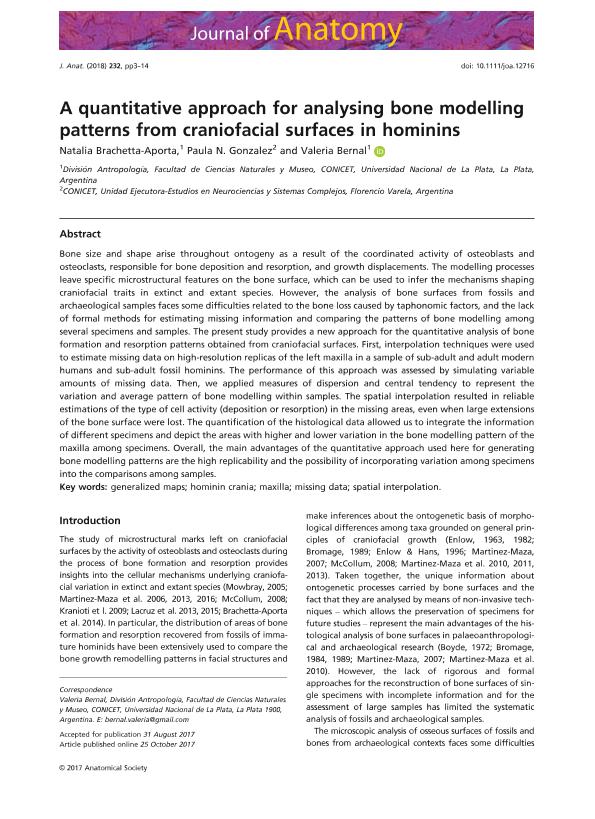Mostrar el registro sencillo del ítem
dc.contributor.author
Brachetta Aporta, Natalia

dc.contributor.author
Gonzalez, Paula Natalia

dc.contributor.author
Bernal, Valeria

dc.date.available
2020-01-15T21:47:14Z
dc.date.issued
2018-01
dc.identifier.citation
Brachetta Aporta, Natalia; Gonzalez, Paula Natalia; Bernal, Valeria; A quantitative approach for analysing bone modelling patterns from craniofacial surfaces in hominins; Wiley Blackwell Publishing, Inc; Journal of Anatomy; 232; 1; 1-2018; 3-14
dc.identifier.issn
0021-8782
dc.identifier.uri
http://hdl.handle.net/11336/94864
dc.description.abstract
Bone size and shape arise throughout ontogeny as a result of the coordinated activity of osteoblasts and osteoclasts, responsible for bone deposition and resorption, and growth displacements. The modelling processes leave specific microstructural features on the bone surface, which can be used to infer the mechanisms shaping craniofacial traits in extinct and extant species. However, the analysis of bone surfaces from fossils and archaeological samples faces some difficulties related to the bone loss caused by taphonomic factors, and the lack of formal methods for estimating missing information and comparing the patterns of bone modelling among several specimens and samples. The present study provides a new approach for the quantitative analysis of bone formation and resorption patterns obtained from craniofacial surfaces. First, interpolation techniques were used to estimate missing data on high-resolution replicas of the left maxilla in a sample of sub-adult and adult modern humans and sub-adult fossil hominins. The performance of this approach was assessed by simulating variable amounts of missing data. Then, we applied measures of dispersion and central tendency to represent the variation and average pattern of bone modelling within samples. The spatial interpolation resulted in reliable estimations of the type of cell activity (deposition or resorption) in the missing areas, even when large extensions of the bone surface were lost. The quantification of the histological data allowed us to integrate the information of different specimens and depict the areas with higher and lower variation in the bone modelling pattern of the maxilla among specimens. Overall, the main advantages of the quantitative approach used here for generating bone modelling patterns are the high replicability and the possibility of incorporating variation among specimens into the comparisons among samples.
dc.format
application/pdf
dc.language.iso
eng
dc.publisher
Wiley Blackwell Publishing, Inc

dc.rights
info:eu-repo/semantics/openAccess
dc.rights.uri
https://creativecommons.org/licenses/by-nc-sa/2.5/ar/
dc.subject
GENERALIZED MAPS
dc.subject
HOMININ CRANIA
dc.subject
MAXILLA
dc.subject
MISSING DATA
dc.subject
SPATIAL INTERPOLATION
dc.subject.classification
Biología del Desarrollo

dc.subject.classification
Ciencias Biológicas

dc.subject.classification
CIENCIAS NATURALES Y EXACTAS

dc.title
A quantitative approach for analysing bone modelling patterns from craniofacial surfaces in hominins
dc.type
info:eu-repo/semantics/article
dc.type
info:ar-repo/semantics/artículo
dc.type
info:eu-repo/semantics/publishedVersion
dc.date.updated
2019-10-16T18:27:19Z
dc.journal.volume
232
dc.journal.number
1
dc.journal.pagination
3-14
dc.journal.pais
Reino Unido

dc.journal.ciudad
Londres
dc.description.fil
Fil: Brachetta Aporta, Natalia. Consejo Nacional de Investigaciones Científicas y Técnicas. Centro Científico Tecnológico Conicet - La Plata; Argentina. Universidad Nacional de La Plata. Facultad de Ciencias Naturales y Museo. Departamento Científico de Antropología; Argentina
dc.description.fil
Fil: Gonzalez, Paula Natalia. Universidad Nacional Arturo Jauretche. Unidad Ejecutora de Estudios en Neurociencias y Sistemas Complejos. Provincia de Buenos Aires. Ministerio de Salud. Hospital Alta Complejidad en Red El Cruce Dr. Néstor Carlos Kirchner Samic. Unidad Ejecutora de Estudios en Neurociencias y Sistemas Complejos. Consejo Nacional de Investigaciones Científicas y Técnicas. Centro Científico Tecnológico Conicet - La Plata. Unidad Ejecutora de Estudios en Neurociencias y Sistemas Complejos; Argentina
dc.description.fil
Fil: Bernal, Valeria. Consejo Nacional de Investigaciones Científicas y Técnicas. Centro Científico Tecnológico Conicet - La Plata; Argentina. Universidad Nacional de La Plata. Facultad de Ciencias Naturales y Museo. Departamento Científico de Antropología; Argentina. Consejo Nacional de Investigaciones Científicas y Técnicas; Argentina
dc.journal.title
Journal of Anatomy

dc.relation.alternativeid
info:eu-repo/semantics/altIdentifier/doi/http://dx.doi.org/10.1111/joa.12716
dc.relation.alternativeid
info:eu-repo/semantics/altIdentifier/url/https://onlinelibrary.wiley.com/doi/full/10.1111/joa.12716
dc.relation.alternativeid
info:eu-repo/semantics/altIdentifier/url/https://www.ncbi.nlm.nih.gov/pmc/articles/PMC5735055/
Archivos asociados
